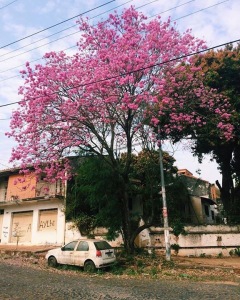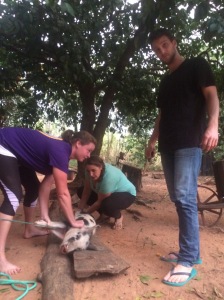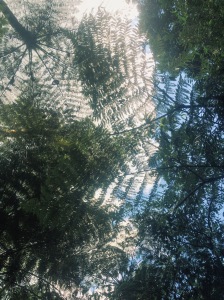Aheka- I search for (ndahekai is the negation). Chica’i- a jopara word for girlfriend
I am most definitely not looking for a girlfriend.
I had been acting weird all day. Chara and I knew each other well enough by then, even after only three short months of service, that she knew something was going on. Pretty much every hour, on the hour, I would look at her strangely and ask, “Uhhh…. how ya doin’?” And she would say, “Okayyyy” or “Umm.. good?” and then walk out of her house or make herself busy or change the topic and I would give up and wait another hour before attempting to steer a conversation. Later, I found the moment. We were standing in the pitch dark at 2 AM on the corner of her community, waiting for the bus. There was no moon and both of us were staring up at the stars. You could see millions of them and the entire Milky Way was shimmering in a long arc across the sky. Neither of us had gotten used to seeing so many stars and so many unfamiliar constellations, but they were all shining so bright that you just couldn’t be in awe of what was above you. Our necks craned toward the sky, I said to her in the dark, “I have something to tell you.”
You go through your service constantly badgered about having a girlfriend or not. I still do, but the frustration has died and has opened up to acceptance. I use humor as a reprieve, a way to divert the conversation and take advantage of their laughter to change the topic. Weather. Crops. Their family. Health. Anything but that.
I was once asked by a customs agent at the border crossing back into Paraguay if I had a girlfriend yet. This was before he asked where I was coming from or if I even had a visa.
Your first three months in a small rural community offer a lot of time to think. Most of the time you don’t understand what’s being said, so you drift into your own mind. You get lost in thought. You spend a lot of time alone, in a hammock, trying to escape the heat, but instead weird emotions find you. It’s hard enough being in a new culture, a new place, a hot place, a confusing place, but then you start questioning yourself. Maybe you’ve been lying to yourself.
My host brother Abundio told me I should marry his daughter Lucy and take her back to the US. She’s 15. I respectfully declined. Such is the way of Paraguayan culture. It’s a family-driven culture. A man or woman should not be single once they’ve reached a specific age. There are rigorous gender roles and households to run, work to do, needs to be met by both. and wouldn’t you want your daughter to go to America? But sometimes, it becomes a bit much for volunteers to handle. People get pushy about it. Or it moves past what we consider appropriate in American culture. Sometimes it moves past what people consider appropriate even in Paraguayan culture.
I’m at the school with the kids. They all voluntarily came in on a day off to work with me in the school garden, even though Profe Mariane couldn’t come. We’re jabbering away in Guarani and they’re being oh-so-guapo digging and planting and watering in the garden space. I’ve spent the last year and a half getting to know these kiddos and they’re all so ridiculous, full of energy and questions. We took a break to sit in the shade of the school terrace and drink terere. Rolando passes me the guampa and asks, “Chance, how do you say ‘puto‘ in English? Or ‘gay’?” I stare at him. None of them have ever expressed interest in English. Never. They all looked at me with anticipation and I steered around the question, a weird feeling in my chest. “Why?” I asked.
“Profe Mariane told us to ask you.”
I continue using humor as a defense when someone asks me if I’ve found a chica’i yet. I’ve been here four years and Paraguayans find it reasonable that I should have found someone. My usual responses are Ndaipori kuña porã Paraguaipe. There aren’t any pretty girls in Paraguay. Che sogue ha la kuña ochupa la plata. I’m broke and a girlfriend will take all my money. La kuña omojupita che presion. A girlfriend will give me high blood pressure. All said with a smirk, followed by laughter. I use an old guarani word for “girlfriend”, instead of the usual chica’i, that usually gets a good laugh. Kichi’ha. Ndaitopai che kichi’ha. Most haven’t heard that word in forever. They get distracted.
I receive a whatsapp message on my American number from a Paraguayan. I don’t give that number out to people from Alto Vera. It’s one of my students from the high school. He has to be 16 or less and lives in Chara’s community. He keeps telling me he wants to ‘get to know me’ and I keep asking him where he got my number. He tells me he found a phone in the road with my number in it. I ask Chara if she gave it to him. She says no, so I tell her what excuse he gave me and she says that several men have made advances on her, saying they found her number in an abandoned phone on the road. You would think all of Paraguay was just tossing their phones onto the road as they speed by on their motos. He texts me again, this time with something even less solicited. I have no choice but to block his number.
I know a lot of female volunteers who have had undesirable experiences with men in Paraguay. It’s a deeply rooted machista culture and something that we all have to find a way to maneuver. Girls definitely deal with far more unsolicited bullshit, but men also have our own barriers to overcome. Add in other layers that volunteers identify with, gender identities, sexual orientations, and pressure builds up inside. It’s a concept that must be tiptoed around, kept to yourself except on very certain occasions. I know volunteers who have come out to their host families, had conversations with counterparts about taboo topics, felt free to express themselves, and it’s gone great. But there are poor experiences as well. Some aren’t so lucky.
I moved to Asuncion and found that there is a progressiveness here among my generation. Minds are more open, but this is a generation defying the conservative thought-processes of their parents that were set in during the dictatorship. There are more conversations being had, more activism, less limitations.
“Profe Mariane told us to ask you.”
My heart skipped a beat. 12 little faces smudged with dirt were all staring at me. Collecting myself, I did the best I could. “Well you all know ‘puto‘ is not a nice thing to say, right?” We talked. We talked about why it’s bad. That calling someone a ‘faggot’ isn’t appropriate. And that ‘gay’ is ‘gay’ in English. “Do you know what that means?” I asked. “It means a man can love a man, or a woman can love a woman. And that’s okay. Because love is love,” I said. They all looked at me nodding their heads. “Right?” “Right,” they all said. “Good. Don’t say ‘puto‘. Now go back to planting in the garden.” And they all ran off to go back to work, leaving me sitting there pondering a lot of heavy stuff.
I was sitting in front of a large circle of people. All of Peace Corps Paraguay’s staff was looking at me as I sat next to five other strong, anxious volunteers. We had been invited to speak at Peace Corps’ staff diversity training and tell our stories. I know every single one of those faces well. The other five volunteers had nominated me to go first and everyone was waiting for me to start. Telling a story this heavy brings up a lot of emotion, a lot of past memories and conflicts, personal doubts and lies you told yourself, commentaries made by others and tears that have followed. Those tears welled up again. Fear and anxiety and sadness and an exhilaration had built up in my chest. I began, “The first time I heard the word ‘gay’, I was in the fifth grade…”
Our necks craned up to the sky, staring into the universe and up at the stars, I knew it was the perfect moment. There in the dark, with my best friend, I said, “I have something to tell you.” “Yeah?” Chara responded. Deep breath. A heart beat. A plunge into the unknown. “I’m gay,” I said, for the very first time ever, there under the stars in the middle of nowhere, Paraguay. I couldn’t see her in the dark, but I knew Chara was smiling. Both of us were. There was a sense of relief inside me and only Chara could have said what she said. “Oh thank God! You’d been acting weird all day and I thought you were going to hit on me!” We burst into laughter. “Quite the opposite really.” And there we were, hugging under the stars and I accepted it all; the frustrations and the comments, the secrets and the pain. But the happiness of being me will stick with me and be a part of this experience forever.
That was three years ago.
It is not easy. It never has been. But Paraguay has given me a lot. It opens my eyes every day to something I did not see before. I have seen a culture I previously knew nothing about. I have walked into strangers’ homes and seen their lives. I have witnessed pain and happiness. I have seen poverty and wealth, often in the same moment. I have walked dirt roads in torrential rains and on excruciatingly hot days. I have been handed a guampa, a mandarin, a kitten who would be named Moritz, keys to a little wooden house, a yerba mate sapling, a hot chipa, a shovel, so many memories. I have been given plenty and seen the world and discovered so much. My eyes were opened to things I did not see before. And sometimes, that happened to be my own true self.

























